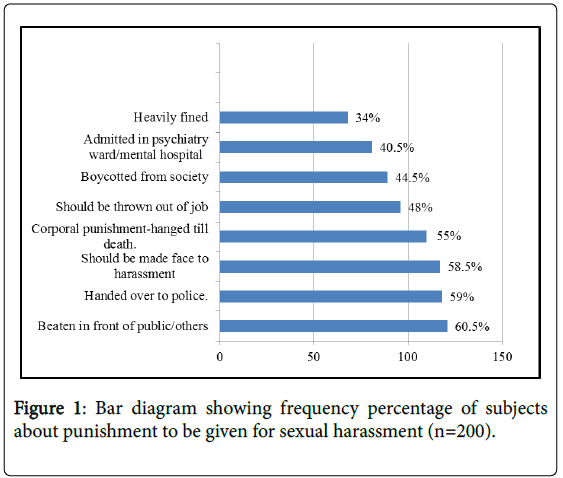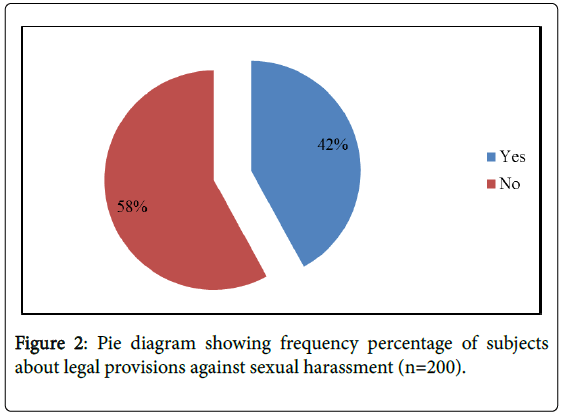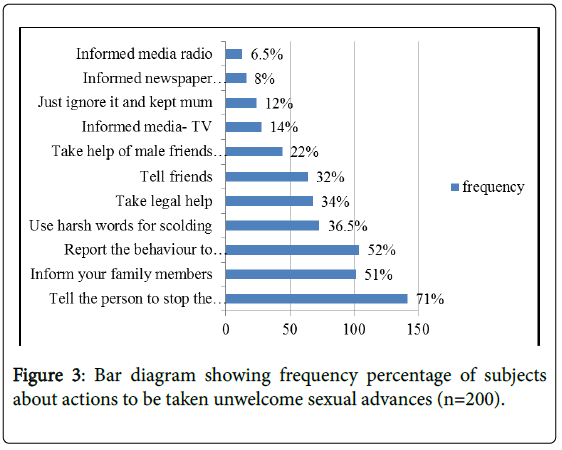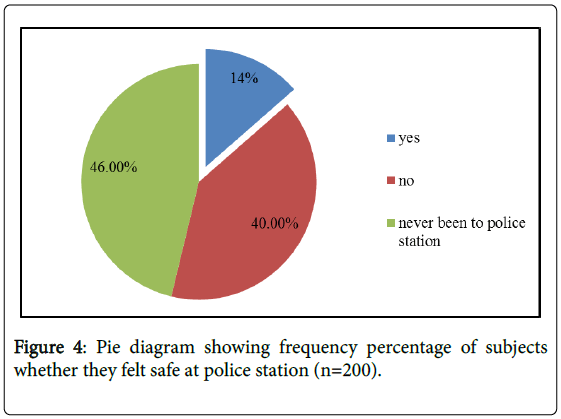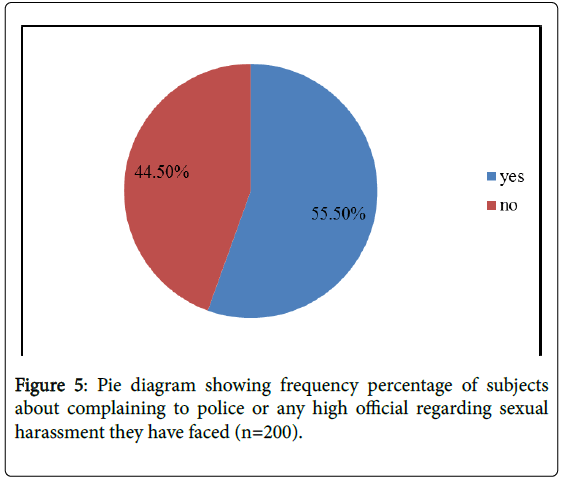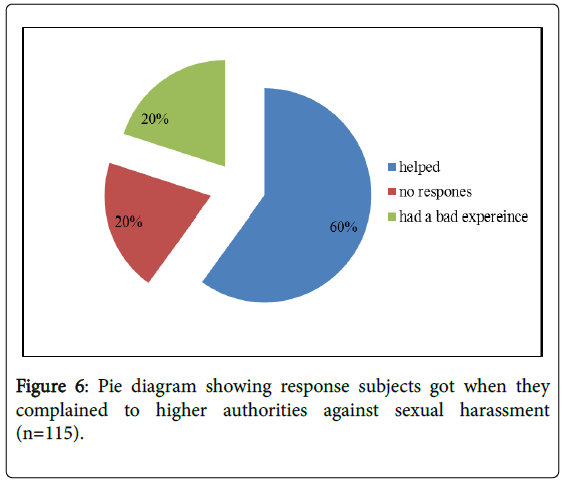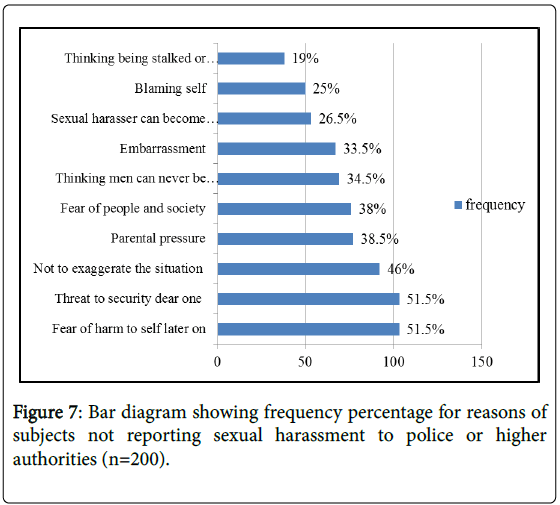Approaching Legal System against Sexual Harassment -A Dilemma among Young Female Adults
Received: 17-Jan-2018 / Accepted Date: 06-Mar-2018 / Published Date: 23-Mar-2018 DOI: 10.4172/2572-0899.1000111
Abstract
Introduction: Knowledge regarding legal options decreases the chance of any unwanted sexual harassment. Early reporting helps reduce the mental harassment faced by the victim.
Study design: A cross sectional survey was done among 200 young female adults studying in degree courses in the age group of 17-21 years from four selected colleges of Delhi University, two co-educational colleges and two women colleges by convenient sampling method. Tool used self-structured questionnaire for assessing the awareness of Young female adults about legal aspects against sexual harassment.
Results: Most of the subjects wanted legal actions to be taken against harasser and were in favour of social punishment as well as legal penalties. Only one tenth of the subjects felt safe with the police officials or at police station and was having faith on services on police for action against sexual harassment as they feared harm to self. There is need for creating awareness about where to approach for help and reporting regarding any sexual harassment incidence faced by victim.
Keywords: Sexual harassment; Emergency department; Forensic nursing; Legal system
Introduction
Strategies for avoidance of sexual harassment are essential for everyone, whether female or male right from childhood. Perception of threat from a situation makes an individual alert and decides when to take action for self-safety. Strategies involve understanding the meaning of sexual harassment. Defying the myths that a little bit uncomfortable behaviour is not harassment. Knowledge regarding legal options available further decreases the chance of any unwanted sexual harassment [1]. Early reporting helps reduce the mental harassment faced by the victim. Most of the cases of sexual harassment goes unreported either due to ignorance, fear of defamation or selfharm or harm to family members. Reporting police or higher authority is still a dilemma to the victims of sexual harassment. Knowledge of students about legal acts and the definition of sexual harassment defined in this is reported to be minimal. Yugantar educational Society [2] reported about sexual harassment at workplace in Maharashtra among 600 working women employed that a large number of cases of sexual harassment went unreported as subjects’ feared defamation or threat to self [3].
Objective
To find out the awareness of young female adults about actions to be taken against sexual harassment including legal provisions and training to prevent and combat sexual harassment.
Methodology
A quantitative approach , cross sectional survey was used and 200 young female adults studying in degree courses in the age group of 17-21 years from four selected colleges of Delhi University, two coeducational colleges and two women colleges were included by convenient sampling method. Students unwilling to participate were excluded from the study.
Tools used: Subject data sheet: structured questionnaire for socio demographic profile and selected variables of the subjects and informed consent form. Tool 1: Structured questionnaire (AQ) (40items-multiple answer questions) for assessing the awareness of Young female adults about legal aspects against sexual harassment. The content validity was done and reliability of the tool was assessed by test retest method by Mc Nemer Chi square test and p value was found not significant for all questions. Pilot study was done on 30 subjects and was found to be feasible. Ethical clearance was obtained from ethical committee of AIIMS, New Delhi and informed consent was obtained from subjects. The data was collected from June to November 2014. Data were analysed using STATA 16.1 by appropriate descriptive statistics-frequency, percentage and inferential statistics- Pearson’s chi square test and Fisher exact test (Figures 1-7 and Table 1).
| Items listed about training to prevent and combat sexual harassment | Frequency (f) | Percentage (%) |
|---|---|---|
| Physical training like karate, judo, commando training | 162 | 81 |
| Raising alarm and calling for help | 126 | 63 |
| Yourself verbally scolding the person | 97 | 48.5 |
| Avoiding such situation before hand | 83 | 41.5 |
Note: More than one answer allowed
Table 1: Frequency distribution showing awareness of subjects about training to prevent and combat sexual harassment (n=200).
Results
Mean age of the subjects was 18.77 ± 1.118 years and the maximum age was 21 years and minimum was 17 years. Nearly a quarter (36%) of the subjects were doing a bachelor degree in arts, 33.5% of the subjects in science and 30.5% of the subjects were doing in commerce. All subjects were unmarried. Almost half (54%) of the subjects had a monthly family income greater than Rs 60,000/-. Most (89.5%) of the subject belonged to Hindu religion, had a nuclear family and were residing in urban area in Delhi NCR. Most (80%) of the subjects had the view to stop unwanted behaviours then and there itself if one feels discomfort and only 11.5% of subjects felt unwanted behaviour should never be stopped and enjoyed as a fun activity. Most (60.5%) of the subjects reported that harasser should be beaten in front of public to teach a lesson to others, only 59% of subjects said harasser should be handed over to police. Most of the subjects wanted legal actions to be taken against harasser and were in favour of social punishment as well as legal penalties. Only 13.5% of the subjects, felt safe with the police officials or at police station. Only one tenth of the subjects were having faith on services on police for action against sexual harassment and half (51.5%) of the subjects feared safety of self and family after reporting sexual harassment. Most (81%) of the subjects reported physical training like karate judo, commando training most effective to combat sexual harassment where as 63% of the subjects reported raising their voice against sexual harassment and taking help from others as most effective.
Discussion
Most (89.5%)of the subjects reported mental distress as the most common suffering faced by victim following sexual harassment, these findings are supported by Sheikh et al. [4]. In the present study nearly two fifth of the subjects felt unsafe with the police officials or at police station. More than half of the subjects had attempted to complain to police or go to higher official about sexual harassment and 45% never complained to any higher authority, these findings were contrary to survey by Jagori survey [5] where most (58%) of the subjects would not consider reporting to police and only 0.8% of subjects would like to report to police. One fourth of the subjects were helped and even a few (10.5%) of the subjects had a bad experience. Nearly half (51.5%) of the subjects did not report to police or higher officials as they feared harm to self or to their near ones, these findings are supported by Dizimadi [6] that subjects feared safety consequences after reporting sexual harassment.
Conclusion
Most of the subjects included in this study showed less than satisfactory awareness about legal help available against sexual harassment. Therefore, there is need for creating awareness about where to approach for help and reporting regarding any sexual harassment incidence faced by victim. More emphasis needs to be paid for mass education regarding positive aspect of taking legal help against sexual harassment.
Implications
Youth need to be aware and avoid risk factors for safety of self and how to report the incident to prevent further harassment. In all institutional settings committee for reporting cases and counselling for sexual harassment victims need to be present.
Recommendations
Similar study can be done with larger sample size, with a qualitative approach, among different college going population, general population among boys and men.
References
- http://www.dnaindia.com/mumbai/report_sexual-abuse-is-on-the-rise-in-city-colleges_1136693
- http://ncw.nic.in/pdfreports/sexual%20harassment%20in%20Maharashtra-report.pdf
- Sheikh Z, Khatoon F, Bataool S, Mushtaq M, Siddiqui F (2014) A survey to assess the female sexual harassment in the higher educational institute of Karachi. Sci J Psychol 2014: 259
- Suri SN (2010) Safe cities free of violence against women and girls initiative: A draft strategic framework for women's safety in Delhi 2010.
- http://ncw.nic.in/pdfreports/sexual%20harassment%20in%20Maharashtra-report.pdf
Citation: Mohanan K, Gupta S, Sagar R (2018) Approaching Legal System against Sexual Harassment -A Dilemma among Young Female Adults. Glob J Nurs Forensic Stud 2: 114. DOI: 10.4172/2572-0899.1000111
Copyright: © 2018 Mohanan K, et al. This is an open-access article distributed under the terms of the Creative Commons Attribution License, which permits unrestricted use, distribution and reproduction in any medium, provided the original author and source are credited.
Select your language of interest to view the total content in your interested language
Share This Article
Open Access Journals
Article Tools
Article Usage
- Total views: 5255
- [From(publication date): 0-2018 - Aug 02, 2025]
- Breakdown by view type
- HTML page views: 4383
- PDF downloads: 872

